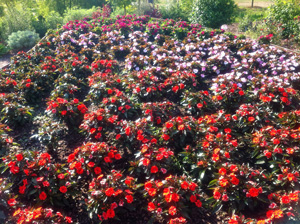Resource Library
Plant of the Week: ‘SunPatiens’ (Impatiens)
The University of Arkansas System Division of Agriculture does not promote, support or recommend plants featured in "Plant of the Week." Please consult your local Extension office for plants suitable for your region.
Plant of the Week
Impatiens ‘SunPatiens’

I used to have a list in my head of bedding plants that grew best in the sun and a shorter but tried-and-true list of those that really needed shade. With the Sun Coleus that swept the garden world 15 years ago, the notion of confining plants to neat little boxes began to crumble. Now with impatiens, SunPatiens®, that grow in the sun my mental list is rendered useless.
SunPatiens look pretty much like New Guinea Impatiens except they truly do tolerate the heat and humidity of a southern summer where they bloom from planting until frost. The breeder, Sakata Seed Company of Japan, has introduced three series types – vigorous, compact and spreading – and more than 15 cultivars so far.
The three vigorous clones are background plants that can reach 4 feet or more in height. The compact plants grow 2 to 3 feet in height with an equal spread. The spreaders are 2 to 3 feet tall with a spread of 3 to 4 feet. These are big plants with the 2-inch flowers produced at the top of the shoot and available in the typical array of impatiens colors. A few variegated forms are also available. In addition to size, the stems and roots are robust and sufficiently well endowed to take the torture offered up during the season of trial we call summer here in the south.
One of Sakata’s plant breeders, Moriya Kawashima, made the initial crosses for the SunPatiens impatiens in 2003 at the Sakata facility in Salinas, Calif. A proprietary breeding line of New Guinea impatiens (I. hawkeri) and an unidentified wild species also maintained as a proprietary line was crossed to create the new sun-loving impatiens. So far we have seen no seed pods develop on our plants, so like many interspecific hybrids, they are probably sterile. As such will continue to flower prolifically in a vain attempt to set seed. Plant patents began appearing in 2008 and plants began to show up in retail markets by 2009.
One source says the wild species, which is not identified in the plant patent application, is a wild strain of I. walleriana, the typical species we have grown in our gardens for years. This seems plausible because most of the modern standard garden impatiens originated from plants Claude Hope collected in Costa Rica he found growing in sunny spots as 3-foot-tall weeds along the roadways just after WW II. These weeds were originally introduced from tropical Africa before 1880, so they were no stranger to heat and humidity.
SunPatiens are large plants best used in big, bold beds, at the back of a bed of annuals or, if you have large containers, in sunny patio pots. Their overall height can be affected by the distance between plants. Crowd them close together – say 12 inches apart – and you will have taller plants. Plant them on 2-foot spacing and the shorter height of the series range will be achieved.
From a cultural standpoint they are considered easy to grow so long as the bed is not planted too far from the water spigot. They need lots of water and provisions must be made to give them the moisture they need on a daily basis. Good soil preparation and a slow release fertilizer applied at planting will give them the nutrition they need to make it through the summer. These impatiens need the sun, so sites with less than half a day of sun should be avoided. While older New Guinea hybrids were considered more sun tolerant than standard impatiens, it is a balancing act to give them the right amount of sun and moisture to get them to flourish. The SunPatiens are much easier to grow than the New Guineas.
By: Gerald Klingaman, retired
Retired Extension Horticulturist - Ornamentals
Extension News - July 13, 2012
The University of Arkansas System Division of Agriculture does not maintain lists of retail outlets where these plants can be purchased. Please check your local nursery or other retail outlets to ask about the availability of these plants for your growing area.